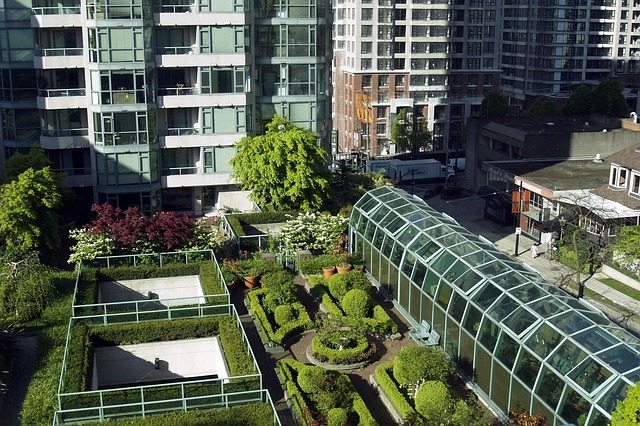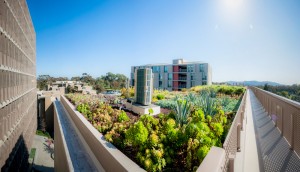Native Plants Suitable For A Green Roof

In this short list are several succulents, and two grasses. Several groundcovers, a few bulbs, and some perennials would also be worthy contestants but all these would require regular maintenance, so they are not included.
SUCCULENTS:
 General Characteristics of Dudleyas—
General Characteristics of Dudleyas—
Approximately 40 species native to California and Mexico
Members of stonecrop family (Crassulaceae)
Can survive 20 or 50 years with little care.
Some are summer deciduous, (actually disappearing in summer) and die if watered in summer.
Others are evergreen, or will remain evergreen in foggy climate or with light occasional irrigation.
Most like to go dry in late summer.
Some species resent any summer irrigation.
Plants attract birds who collect and disperse the fine seeds.
Seeds are also spread by wind, may sprout on bare banks in the region thus helping spread these beautiful and non-weedy native plants.
When dudleyas fail in cultivation it is usually from root rot from over-watering.
All can survive without summer irrigation, though leaves may shrivel.
The following dudleyas that are available in the trade and worth trying on this green roof.
Fingertips, Ladies Fingers—(Dudleya edulis)
Attractive, low (1 foot tall and wide) evergreen plant. Native to San Diego coastal region. Grayish green foliage is edible, a source of food of Native Americans. Can take light, occasional summer irrigation. Needs some summer irrigation for survival if grown in full sun in sandy soil. I have observed it growing in pine needle debris on a north-facing, tile roof at the top of the Del Mar hill where it survived at least 45 years that I know of and stayed green year round with no summer irrigation other than drips of moisture on foggy days from overhanging foliage. Can take summer water. Its “fingers” will stay more plumped up through summer if occasionally watered very lightly overhead (like a light summer rain) or by drip. Plants are available at Las Pilatas Native Plant Nursery.
Catalina Island dudleya,—(D. virens ssp. hassei)
Evergreen plant endemic to Catalina Island, makes an excellent ground cover. Plants spread in profusely-branched mounds 6 to 8 inches high and wide. Tolerant of heavy soil.
Frank Reinelt dudleya, Anacapa dudleya (D. ‘Frank Reinelt’, D. ‘Anacapa’)
Improved selection with tight low mounds, 6 to 8 inches tall and 12 inches wide with profuse yellow flowers in spring. Silvery leaves flush rosey-purple in winter. Available from Native Sons Nursery, others.
Candleholder dudleya—(D. candelabrum)
Among many island endemic dudleyas this one from Santa Cruz, Santa Rosa, and San Miguel islands is adapted to rocky soil. Rosettes of leaves are not finger-shaped, but measure 6 to 10 inches across. The leaves are chunky, green, flattened, and send up tight clusters of pale yellow flowers in spring, hence the name.
Britton dudleya—(D. brittonii)
Most popular of dudleyas, prized for its stunningly large (6 to 12-inch) rosette of luminous, whitish or silvery leaves. In spring sends up a tall (1 to 2 1/2 foot) flower stalk which turns red when it bears its yellow flowers. Makes a good pot plant since must have good drainage. Worth trying on the roof but may die from root rot and unlike other varieties named here, might need some brown leaves removed.
General Characteristics of Native Agaves
Most agave’s are too large for use on a roof or are native to hot interior regions and do not do well along the coast. However, the following agave is native to the coast and small enough for a roof. It can be seen growing wild in Torrey Pines Park and on coastal bluffs throughout southern California.
Shaw agave—(Agave shawii)
Bold-looking, architectural rosettes (3-foot tall and 2 feet wide) of succulent, sharply-spined, leaves are handsome year round and can be used as an effective barrier against foot traffic. Individual plants eventually create large colonies forming strong, sculptural accents. Can be used in drifts for good effect. Once an individual has matured it will send up a 7 or rarely even to 12 foot tall flower stalk with attractive rounded yellow bloom clusters that are irresistible to hummingbirds. A negative factor to this plant is that after bloom the entire rosette dies (though not the clump.) In nature the plants remain highly attractive despite the dead rosette and browning flower stalk bearing seed pods after blooms fade, but in a garden or perhaps on a roof, people may feel that the one dead rosette should be removed from the clump of new plants that by now has grown up around it. Also the flower stems may be too tall for harmonious appearance on a roof.
Shaw agave can adapt to irrigation and occasional water may improve its appearance in dry weather especially in shallow soil.
GRASSES
The main reason for any objection to grasses on this roof is the possible need for occasional mowing for safety and appearance, which might be difficult on a roof. A second reason is the problem with seedlings sprouting in the lagoon area. Nonetheless, here are two native grasses that don’t not seem to be particularly invasive and might be a good choices, providing an excellent appearance year round, and also might do well on this roof with little or no mowing:
Red Fescue—(Festuca rubra ‘Slopesaver’)
Red fescue is native to moist climates in California and is widely grown as an ornamental grass to provide an informal greensward or bank cover in sun or shade. It is available as sod or seed in as many as 40 named cultivars, the best known of which is given above. Given regular irrigation it maintains a beautiful green appearance year round. Tufted drifts 3 to 12 inches high spread by rhizomes. This grass is disease and pest free. It can be grown without mowing or can be mowed with a weed wacker if desired. Gray selections are drought-resistant. Red fescue would provide an extremely attractive sod roof and has been successfully used for this purpose.
Blue grama—(B. gracilis)
A tough, very drought-resistant, bunch grass that forms slowly spreading tufts, 4 to 16 inches tall, of wiry grass. It must have full sun and will die if over-watered. Allowing it to dry out completely between summer irrigations may be the best way to keep it happy. Best adapted to the hot, dry interior where it goes brown in winter, this grass may stay partially green in winter in this coastal zone, but it may not do as well as red fescue in a foggy coastal zone.


hi patwelsh.com-ers merry xmas to you all – matty mays